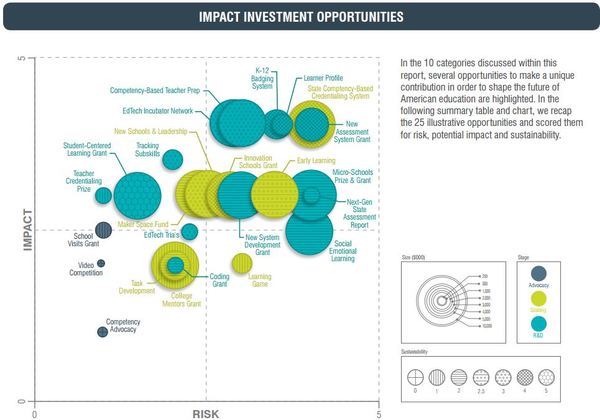Top 10 ‘Impact Investing’ Opportunities Identified for K-12 in Report
Where can foundations, companies, and even governments get the most social impact “bang for their buck” in K-12 education?
A new report attempts to answer that question, singling out the top 10 areas recommended for investment, along with the costs and risks associated with each of 25 opportunities within those general categories.
The report’s findings are based on research conducted by Getting Smart, an education advocacy firm, on behalf of Vulcan Inc., a company with philanthropic and for-profit entities, that was created by Microsoft co-founder Paul Allen and his business partner and sister, Jody Allen. (Tom Vander Ark, founder of Getting Smart, writes the Vander Ark on Innovation opinion blog for Education Week.)
The study, released last month, identified the following “top 10” areas of opportunity:
- Student-centered learning
- New school development
- Professional learning
- Next-generation assessment
- Teaching entrepreneurial skills
- Portable data and parent engagement
- Learning resources
- Social-emotional learning
- Early learning
- STEM, coding, and computer science
Within these general areas, 25 specific activities were identified and evaluated, based on their risk, potential impact, and sustainability. (The quadrant chart above shows how those opportunities are weighted on a risk-impact scale.) Of the 25 opportunities identified,12 would require commitments of $10 million or more, while two—providing advocacy support about competency-based education for three years, and a video competition about next-generation learning—were requests with funding needs of $300,000 or less.
Five key opportunities were chosen for having the potential “to make a large and unique impact,” according to the report. They are:
- Launching a “micro-schools” design prize, coupled with a grant, to create a platform-based approach that could be rapidly and inexpensively deployed as new schools, or a schools-within-a-school model, for 40 to 50 students and two teachers, for $10.25 million;
- Designing and launching a competency-based teacher preparation system—for $10 million—which would combine a map of competencies, a variety of blended-learning opportunities, and a requirement to demonstrate mastery;
- Developing a K-12 badge system with a $4 million grant that would provide a framework to organize units of study with multiple assessments that would certify learning;
- Supporting the development of learner profiles, which the report defines as “comprehensive, parent-managed profiles” that would “solve the privacy problem” and empower student-centered, extended, and mobile learning, with a $2 million grant; and,
- Establishing a “maker space fund,” for $10 million, which would provide matching grants to support maker spaces in 10 cities; the spaces initially would be developed outside of school to showcase active and student-led learning.
To arrive at the findings, the Getting Smart team conducted interviews with various stakeholders in education, and held a design workshop to define and expand upon the opportunities.
The ideas presented are “not exclusively philanthropic,” David J. Ferrero, senior program officer for education with Vulcan’s philanthropy team, wrote in a blog post about the study. “Some are or could be approached as venture or return-seeking investments. They all see large-scale sustainable impact,” he wrote.
The report’s authors also indicate that it is not an “exhaustive” list of all opportunities available.
“We hope this report will start conversations and further research on the impact opportunities that different organizations could participate in in order to advance high-quality K-12 education,” said Ferrero.
See also:
- ‘Impact Investing’ Forum Features Education Companies
- NewSchools’ Nonprofit Seed Fund Gives Way to For-Profit Investment Arm
- Utah District Sees Pre-K as Tangible Investment
- ‘We the Economy’ Series Brings Short Films on Monetary Topics to Schools
Chart: From “25 Impact Opportunities in U.S. K-12 Education” by Getting Smart, in partnership with Vulcan Inc.

